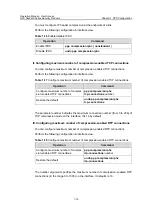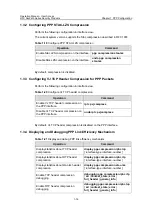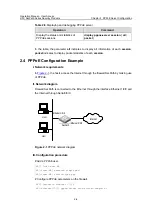
Operation Manual – User Access
H3C SecPath Series Security Products
Chapter 3 PPPoE Client Configuration
3-4
Table 3-3
Configuring a PPPoE session
Operation
Command
Configure PPPoE session (always-on
mode)
pppoe-client
dial-bundle-number
number
[
no-hostuniq
]
Configure PPPoE session (packet
triggering mode)
pppoe-client
dial-bundle-number
number
[
no-hostuniq
]
idle-timeout
seconds
[
queue-length packets
]
Delete PPPoE session
undo pppoe-client
dial-bundle-number
number
SecPath Series Firewalls support two kinds of PPPoE connection mode: always-on
mode and packet triggering mode.
z
Always-on mode: When the physical line is UP, the firewall will quickly initiate
PPPoE call to create a PPPoE session. The PPPoE session will always exist
unless the user deletes it via the
undo pppoe-client
command.
z
Packet triggering mode: When the physical line is UP, the firewall will not
immediately initiate PPPoE call. Only when there is data transmission requirement
will the firewall initiate PPPoE call to create a PPPoE session. If the free time of a
PPPoE link exceeds the value set by user, the firewall will automatically terminate
the PPPoE session.
3.2.3 Resetting/Deleting a PPPoE Session
Execute the
reset pppoe-client
command and the
reset pppoe-server
command in
user view and the
undo pppoe-client
command in Ethernet interface view or virtual
Ethernet interface view.
Table 3-4
Reset/delete a PPPoE session
Operation
Command
Terminate a PPPoE session at the client
end and recreate the session later
reset pppoe-client
{
all
|
dial-bundle-number
number
}
Terminate a session at the PPPoE
server end
reset pppoe-server
{
all
|
virtual-template number
|
interface
interface-type interface-num
}
Terminate a PPPoE session at the client
end and never recreate it again
undo pppoe-client
dial-bundle-number
number
The difference between the
reset pppoe-client
command and the
undo pppoe-client
command lies in: The former only temporarily terminates a PPPoE session, while the
latter permanently deletes a PPPoE session.


























